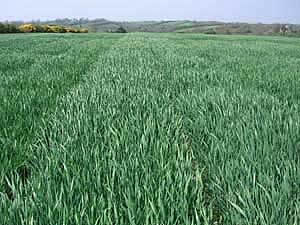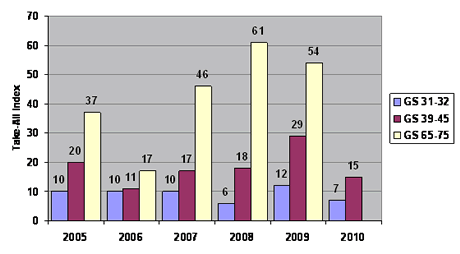 |
|||||||||
|
|||||||||||||||||||
|
|
Take-All Levels Build Despite Driest Spring for 80 Years 2010-07-09 Take-all levels in second wheats have built-up to surprising levels despite the driest first six months of the year since 1929, reveal this season’s NIAB root assessments at HGCA Recommended List trial sites across the country.
From an average of seven on the 1-100 scale for the seven second wheat sites at GS31-32 this season, the Take All Index reached 15 at GS39-45, with two sites showing already moderate levels of infection (indexes above 20). “Noticeably lower than last year’s record mid-season levels, the pattern of take-all build-up is very similar to those we recorded in 2007 and 2008,” explains study co-ordinator, Rob Plaice of Monsanto Crop Protection. “More modest disease levels are hardly surprising given the acute lack of rainfall we’ve experienced so far in 2010. But we are very surprised that infections have developed to the extent that they have; especially so following a relatively dry autumn and cold winter. “The wetness of last summer helped many crops survive take-all damage better than they would have done otherwise,” he points out. “Even so second wheat yields were particularly disappointing – with the RL trial site controls averaging just 7.5 t/ha against an overall 2009 mean of 10.5 t/ha. The experience of this season reinforces Rob Plaice’s concern to ensure second wheats across the country are as well protected as they can be from take-all these days, regardless of when they are sown or under what conditions. “Even when conditions really don’t seem to favour the disease, we are seeing surprising levels of infection,” he reasons. “So, whatever else we do in our second wheat management, we simply have to prioritise take-all protection above almost anything else. “Treating seed with even the most powerful specialist take-all fungicide, Latitude (sithiofam) won’t completely prevent infections. And, in a dry summer we’re likely to see both whiteheads and yield losses even where take-all inoculum levels are relatively low. “However, our research and field experience over more than 10 years shows that restricting early disease development through Latitude seed treatment will reduce the impact of the disease on performance by between 0.5 and 1 tonne/ha. Take-all Levels at HGCA Second Wheat Variety Trial Sites 2005-2010
|
||||||||||||||||||

|
|
||||||||||||||||||
| home | agri-services | pedigree
pen | news | dairy | beef | machinery property | organisations | site map |
|||||||||||||||||||



